Ultra Mobile Devices Market Size and Trends
The Ultra Mobile Devices Market is estimated to be valued at USD 53.31 Bn in 2025 and is expected to reach USD 101.34 Bn by 2032, exhibiting a compound annual growth rate (CAGR) of 9.6% from 2025 to 2032.
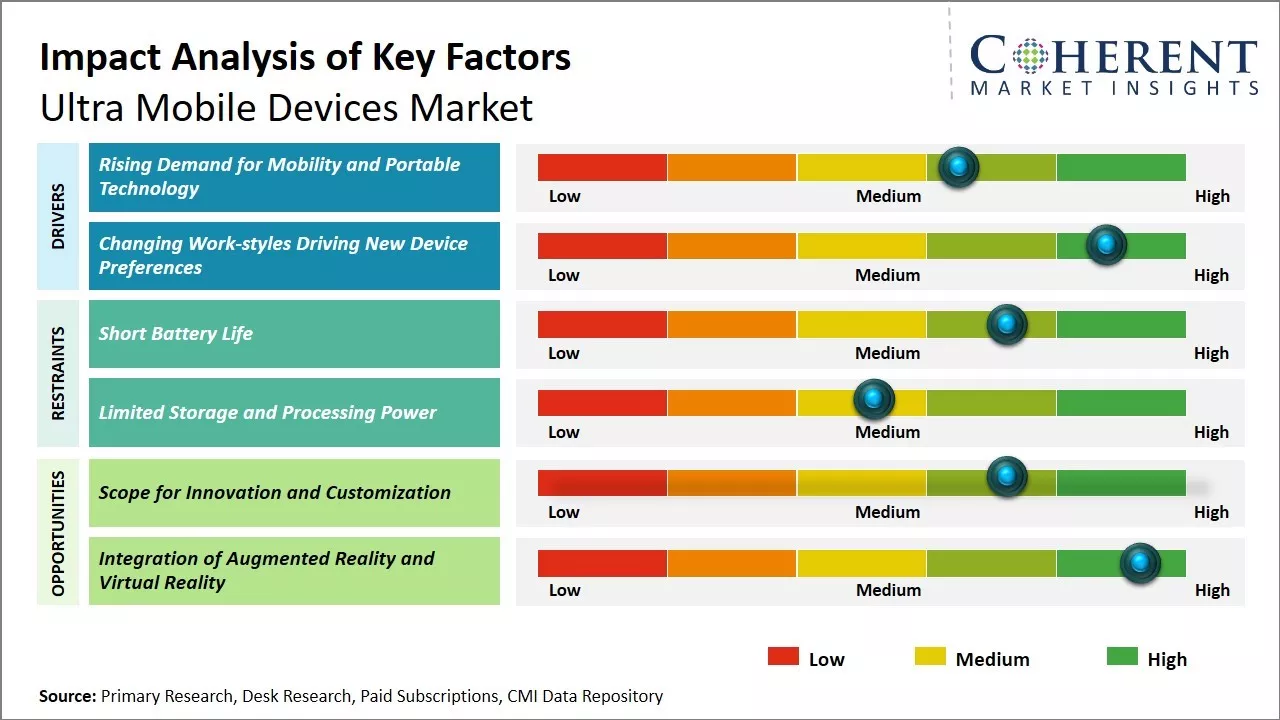
Discover market dynamics shaping the industry: Download Free Sample
The ultra-mobile devices market is witnessing significant growth driven by the rising demand for compact and lightweight computing solutions. Factors such as increasing workforce mobility, growing adoption of BYOD policies by organizations, and rising number of millennials in workforce who prefer ultra-portable devices are fueling the demand. Additionally, technological advancements enabling power-efficient and high-performance devices with long battery life are enhancing the attractiveness of ultra-mobile devices for productivity and personal usage on-the-go. OEMs are innovating devices with new form factors such as foldable devices and dual-screen options to attract consumers. However, high initial costs of these specialized devices and competitive pressures from economical tablets may restraint market potential to a certain extent.
Rising Demand for Mobility and Portable Technology
The modern workforce has become increasingly mobile in recent years. Workers demand technology that allows them to stay connected and productive from any location. Ultra mobile devices perfectly meet this need as their compact size and long battery life make them ideal for mobile professionals. Those in industries such as consulting, finance and field sales rely on being able to access documents, emails and other work tools while on the go. Ultra mobile devices fit easily into briefcases or bags without weighing the user down. They are powerful enough to create and edit documents or crunch spreadsheets yet remain lightweight enough for extended travel.
The bring-your-own-device trend in many companies has further boosted demand. Staff are encouraged to use their personal laptops and tablets for work, provided the devices meet basic security requirements. Ultra mobile devices neatly bridge personal and professional device needs with their combination of power and portability. For globally dispersed companies, they facilitate seamless communication across time zones. Whether making a transatlantic phone call or reviewing documents remotely, ultra mobile computers support virtual collaboration between teams around the world. Their reliability has proven valuable for tasks conducted while in transit such as approving proposals from airport lounges or coordinating schedules during train rides.
For instance, NEC Personal Computers Ltd. (NECPC), a joint venture company of Lenovo and NEC Corporation, offers LAVIE Pro Mobile which provides ultimate portability with its super lightweight (1.96lb) that is designed with new structure carbon material.
Market Concentration and Competitive Landscape
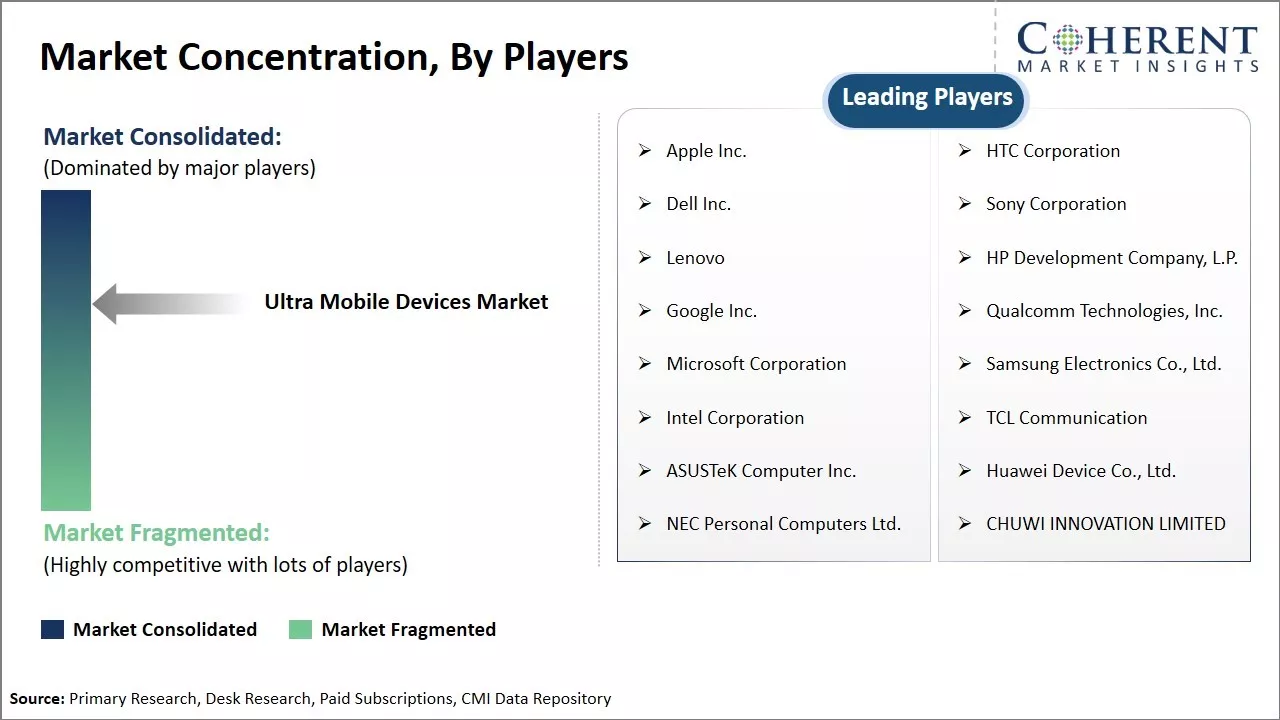
Get actionable strategies to beat competition: Download Free Sample
Changing Work-styles Driving New Device PreferencesWork styles have become far more flexible in recent years as digital technologies allow staff to work where and when it suits them. While the traditional 9-5 workday persists for some, many professionals now blend office time, remote working, and occasional travel into their schedules. Rather than commute daily to a single location, they may work partly from co-working spaces, cafes or even their living rooms depending on tasks for the day. This evolving way of working has placed a premium on mobile devices that support varied styles of productivity.
Ultra mobile PCs perfectly compliment modern flexible work practices. Their portable thin-and-light design makes them highly mobile working hubs that can go anywhere. Lightweight and compact, they slip easily into bags without adding much weight. Powerful enough for full workloads yet with long battery lives of 8 hours or more, they keep users productive throughout the day without depending on power outlets. Models with touch screens adapted to finger navigation further enhance their usability on the move. As personal space becomes a flexible resource for work, ultra mobile devices provide computing capability wherever the user sets up temporarily.
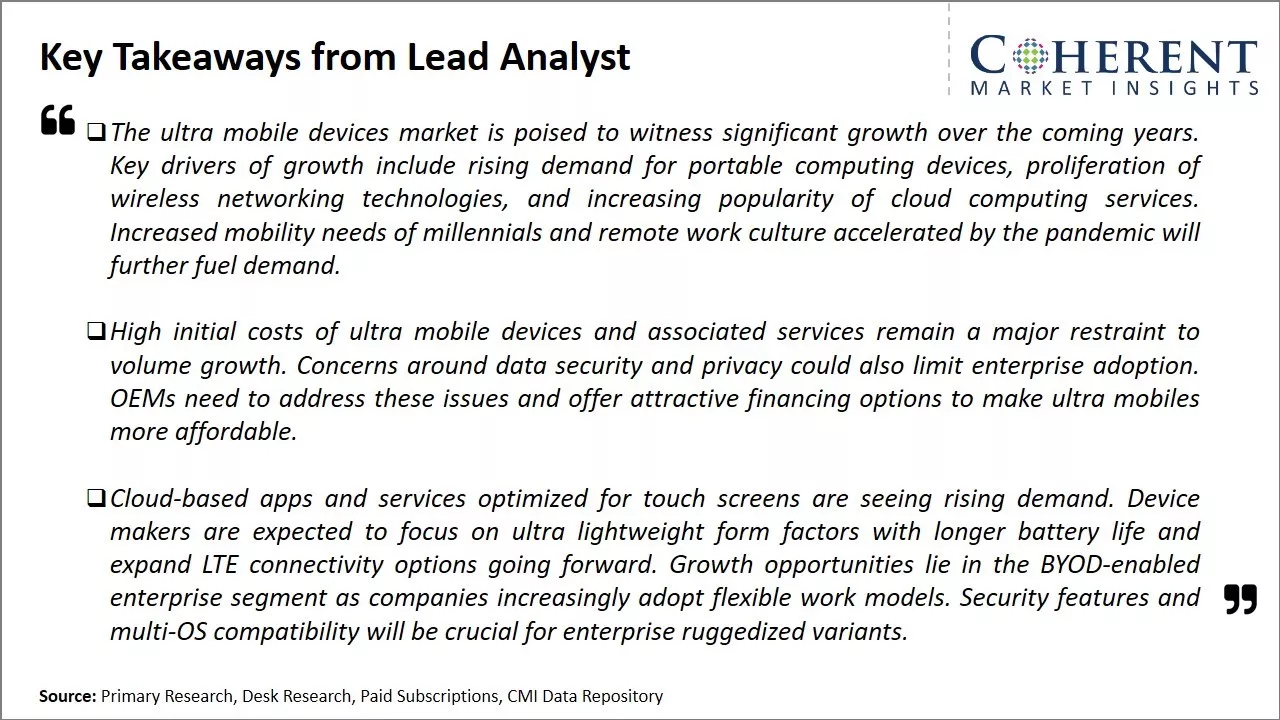
To learn more about this report, Download Free Sample
Market Challenges: Short Battery LifeThe ultra mobile devices market faces several challenges. Devices in this category strive for compact size and portability which limits key components like battery capacity and processing power. As a result, battery life tends to be relatively short and performance may not match larger devices. Additionally, touch interface usability can be impacted on very small screens. Manufacturers must overcome size constraints to provide a functional user experience. Storage is also limited so cloud services are important to offload content.
Market Opportunities: Scope for Innovation and Customization
Compact nature of ultra-mobile devices fills the need for highly portable computers that can be easily carried and used anywhere. As components progress, performance and battery life barriers will start to diminish. If usability challenges are addressed, they have potential for use among road warriors or anyone desiring ultimate mobility. As the Internet of Things expands, these devices may take on new connectivity roles beyond traditional computing.
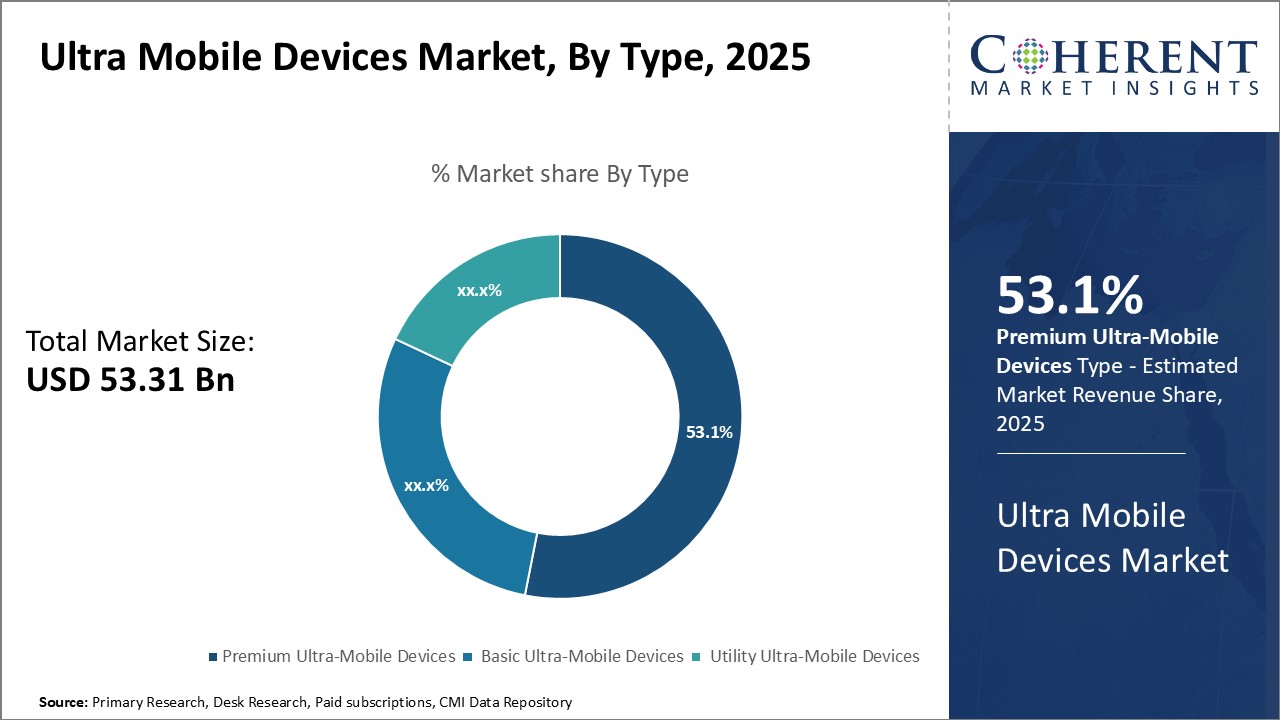
Discover high revenue pocket segments and roadmap to it: Download Free Sample
Insights, by Type - Premium Ultra-Mobile Devices are Gaining Significant TractionPremium Ultra-Mobile Devices segment is estimated to contribute the highest share of 53.1% in 2025 in the market owing to increasing demand for advanced features. Premium ultra-mobile devices are gaining significant traction owing to the increasing demand for advanced features among business professionals and tech-savvy users. These devices offer superior specifications and functionality for niche applications compared to basic models.
Power users prefer premium ultra-mobile devices as they support execution of resource-intensive tasks on-the-go. Their high-end configurations with powerful processors, significant RAM, and storage allow flexible multitasking and seamless switching between various computing and productivity tools. Further, premium designs with vibrant displays and lightweight metallic builds provide an enhanced computing experience.
In the present era of hyper-connectivity and constant digital interactions, advancements like 4G/LTE, WiFi calling and eSIM help professionals remain accessible wherever they are. Premium options stand out with their added support for emerging technologies like 5G. Cutting-edge connectivity ensures uninterrupted high-speed data transfers and connectivity.
Augmenting creativity, premium devices incorporate features such as stylus integration, multi-window view and DEX orcontinuum modes for flexible content creation. Their large, high-resolution touchscreens facilitate tasks such as note-taking, photography editing and media consumption.
Regular security updates and longer periods of software support provide future-proofing for technology enthusiasts. With versatile configurations tailored for productivity, premium ultra-mobile devices have gained widespread acceptance among the performance-oriented user segment.
For instance, NEC Personal Computers Ltd. (NECPC), a joint venture company of Lenovo and NEC Corporation, offers LAVIE MINI”, an 8-inch convertible ultra-mobile PC built for fun and premium entertainment with gaming accessories.
Insights, by End User – Enterprises are increasingly adopting mobile technologies to promote workforce productivity
Enterprises and Businesses segment is estimated to contribute the highest share of 38.8% in 2025 in the market owing to widespread digital transformation. Enterprises are increasingly adopting mobile technologies to promote workforce productivity and collaboration. As organisations pursue digital transformation, there is a growing need for versatile mobile solutions.
Ultra-mobile devices are highly suitable for businesses due to their compact form factor coupled with full-fledged functionalities. Their portable nature allows employees flexibility in working remotely as well as during commutes. This improves workforce mobility and engagement.
Furthermore, progressive features support enterprise job roles and workflows. Advanced specifications smoothly run business applications while supplementary tools like DEX/continuum modes enable desktop-like experience. Built-in protections safeguard sensitive organisational data.
Device management solutions secure and administer distributed business fleets. Integrations with collaboration platforms foster interaction between field staff and head office. Over-the-air updates simplify maintenance of devices.
Coupling agile mobile workflows with legacy systems, ultra-mobile devices play a strategic role in digital operations. Their appeal lies in achieving an optimal balance between potency and portability for always-connected business use on the move. Hence, enterprises continue relying on ultra-mobile solutions to digitally empower distributed workforces.
Regional Insights
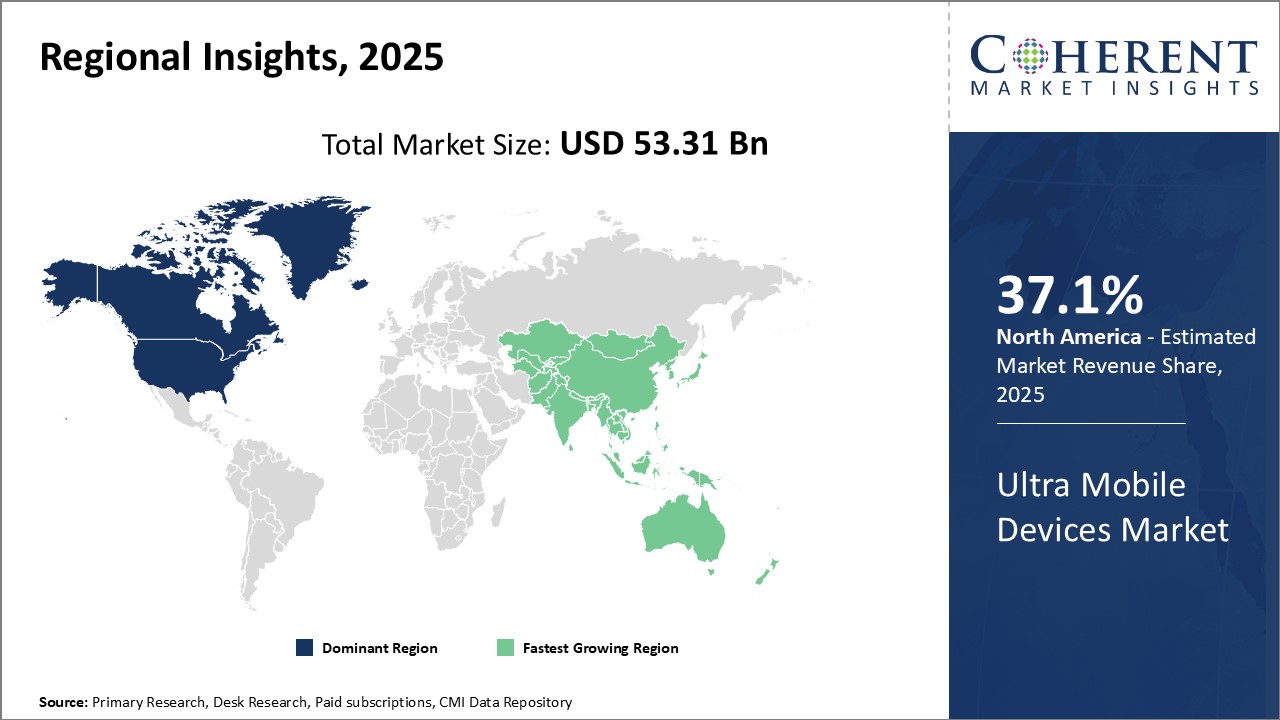
Need a Different Region or Segment? Download Free Sample
North America has dominated the ultra mobile devices market for many years owing to a strong presence of key players in the region. The U.S. accounts for the largest share due to a high disposable income and advanced technology adoption rates among consumers and enterprises. Brands such as Apple, Microsoft, and Dell have their headquarters in the U.S., driving extensive R&D efforts to develop innovative products. This gives North American companies an edge over competitors globally. In addition, lenient intellectual property laws allow companies to quickly bring new devices to the market.
Another important factor for North America's leadership is the high demand from enterprises for thin, lightweight and powerful devices that allow flexible working. Many organizations are shifting toward a Bring-Your-Own-Device policy or issuing tablets and laptops to mobile employees. As a result, there is massive procurement of ultra-mobile devices to support digital transformation and mobile workforces. The region also has a well-developed distribution and logistics network for companies to market and supply new products swiftly.
The Asia Pacific region is witnessing the fastest growth in the ultra-mobile devices segment. While countries like China and Japan have been major manufacturing hubs, newer economies are now becoming important markets. In particular, India is emerging as a lucrative investment and consumption destination. Rising disposable incomes and modern lifestyles are compelling young Indians to purchase premium devices for personal and professional usage. This growing affluence coincides with greater availability of high-speed internet and innovative payment solutions, enhancing the prospective customer base. At the same time, low manufacturing costs give Asian vendors a competitive edge in exports around the world. If current trends hold, APAC will play a more influential role in shaping the worldwide demand dynamics for ultra-mobile products in the coming years.
Market Report Scope
Ultra Mobile Devices Market Report Coverage
| Report Coverage | Details | ||
|---|---|---|---|
| Base Year: | 2024 | Market Size in 2025: | USD 53.31 Bn |
| Historical Data for: | 2020 To 2024 | Forecast Period: | 2025 To 2032 |
| Forecast Period 2025 to 2032 CAGR: | 9.6% | 2032 Value Projection: | USD 101.34 Bn |
| Geographies covered: |
|
||
| Segments covered: |
|
||
| Companies covered: |
Apple Inc., HTC Corporation, Dell Inc., Sony Corporation, Lenovo, HP Development Company, L.P., Google Inc., Qualcomm Technologies, Inc. , Microsoft Corporation, Samsung Electronics Co., Ltd., Intel Corporation, TCL Communication, ASUSTeK Computer Inc. , Huawei Device Co., Ltd. , NEC Personal Computers Ltd., CHUWI INNOVATION LIMITED |
||
| Growth Drivers: |
|
||
| Restraints & Challenges: |
|
||
Uncover macros and micros vetted on 75+ parameters: Get instant access to report
Ultra Mobile Devices Industry News
- In December 2023, Intel Corporate, a semiconductor design and manufacturing company, launched Intel Core Ultra mobile processors and ushered in the first generation of the AI PC. Core Ultra is Intel’s most AI-capable and power-efficient client processor.
- In January 2021, NEC Personal Computers Ltd., a joint venture company of Lenovo and NEC Corporation, announced the launch of the upgraded “LAVIE Pro Mobile” at All-Digital CES 2021. It features all day battery life and featherweight ultra-compact body.
*Definition: The Ultra Mobile Devices Market comprises very light, portable computing devices that are smaller than a regular laptop. These devices typically weigh less than 1.5 pounds with screen sizes 10 inches or below. They run full operating systems with long battery life and storage capabilities. Example products include ultrabooks, netbooks, tablets and convertible laptops/tablets. These highly mobile devices are aimed at mobile professionals, students and frequent travelers seeking portable PCs for productivity, entertainment and internet access on the go.
Market Segmentation
- Type Insights (Revenue, USD Bn, 2020 - 2032)
- Premium Ultra-Mobile Devices
- Basic Ultra-Mobile Devices
- Utility Ultra-Mobile Devices
- End User Insights (Revenue, USD Bn, 2020 - 2032)
- Enterprises and Businesses
- Educational Institutions
- Government and Public Sector
- Individual Consumers
- Regional Insights (Revenue, USD Bn, 2020 - 2032)
- North America
- U.S.
- Canada
- Latin America
- Brazil
- Argentina
- Mexico
- Rest of Latin America
- Europe
- Germany
- U.K.
- Spain
- France
- Italy
- Russia
- Rest of Europe
- Asia Pacific
- China
- India
- Japan
- Australia
- South Korea
- ASEAN
- Rest of Asia Pacific
- Middle East & Africa
- GCC Countries
- Israel
- South Africa
- Rest of Middle East & Africa
- North America
- Key Players Insights
- Apple Inc.
- HTC Corporation
- Dell Inc.
- Sony Corporation
- Lenovo
- HP Development Company, L.P.
- Google Inc.
- Qualcomm Technologies, Inc.
- Microsoft Corporation
- Samsung Electronics Co., Ltd.
- Intel Corporation
- TCL Communication
- ASUSTeK Computer Inc.
- Huawei Device Co., Ltd.
- NEC Personal Computers Ltd.
- CHUWI INNOVATION LIMITED
Share
Share
About Author
Monica Shevgan has 9+ years of experience in market research and business consulting driving client-centric product delivery of the Information and Communication Technology (ICT) team, enhancing client experiences, and shaping business strategy for optimal outcomes. Passionate about client success.
Missing comfort of reading report in your local language? Find your preferred language :
Transform your Strategy with Exclusive Trending Reports :
Frequently Asked Questions
EXISTING CLIENTELE
Joining thousands of companies around the world committed to making the Excellent Business Solutions.
View All Our Clients
